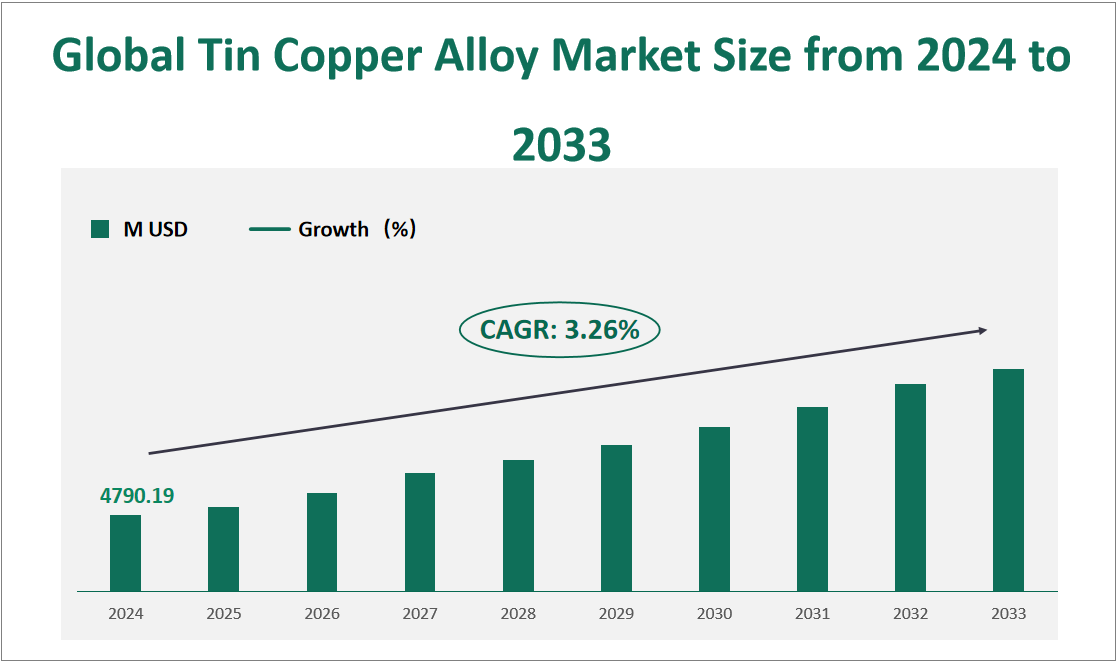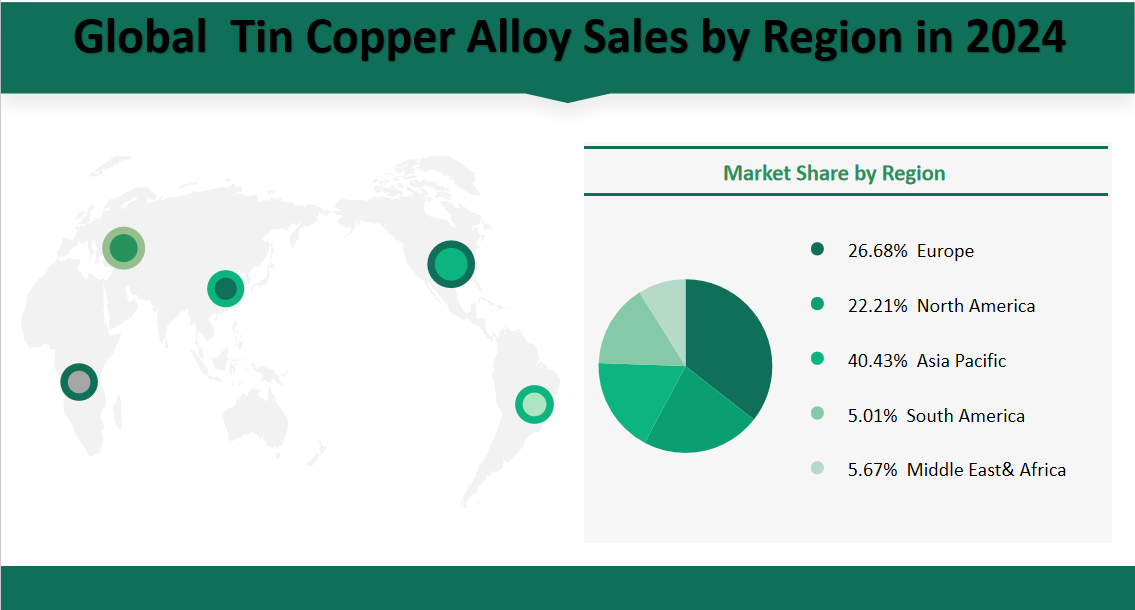1 Global Tin Copper Alloy Market Outlook
The global Tin Copper Alloy market is projected to exhibit substantial growth in the coming years, with a CAGR of 3.26% from 2024 to 2033, reaching a total market size of $4709.19 million USD in 2024. Tin Copper Alloy is an essential material in various industrial applications due to its unique properties, which include high strength, excellent wear resistance, and good electrical conductivity. These alloys are primarily composed of copper and tin, with additional elements such as phosphorus and zinc to enhance specific characteristics. For instance, phosphorus acts as a deoxidizer, improving the alloy’s fluidity and mechanical properties, while zinc enhances fluidity and reduces crystallization temperature.
Figure Global Tin Copper Alloy Market Size and Growth Rate (2024-2033)

2 Tin Copper Alloy Market Growth Drivers and Constraints
The growth of the Tin Copper Alloy market is influenced by several driving factors. One of the primary drivers is the increasing demand from the infrastructure and construction sectors. The development of transportation networks, airports, ports, and urban water supply systems requires robust materials like Tin Copper Alloys. Additionally, the automotive industry’s expansion, particularly in electric vehicles, has spurred demand due to the alloys’ excellent electrical conductivity and mechanical strength.
Another significant driver is the growth in the electrical and electronics sector. Tin Copper Alloys are used in connectors, relays, and other components due to their high electrical conductivity and resistance to wear. The increasing adoption of smart technologies and the Internet of Things (IoT) has further fueled demand in this sector.
However, the market also faces certain limiting factors. One of the primary challenges is the fluctuation in raw material prices, particularly copper and tin. These price volatilities can impact the cost structure of Tin Copper Alloy production, affecting profitability. Additionally, environmental regulations and sustainability concerns have led to stricter standards for material usage, which can pose challenges for manufacturers.
Moreover, the market faces intense competition from alternative materials. For instance, advancements in plastic and composite materials have led to increased competition in some applications traditionally dominated by metal alloys. This competition can limit market growth by reducing demand for Tin Copper Alloys in certain sectors.
3 Tin Copper Alloy Market Innovations and M&A Activities
Technological innovation plays a crucial role in the Tin Copper Alloy market. Manufacturers are continuously investing in research and development to improve the performance and sustainability of their products. For example, advancements in vacuum smelting and compound refining processes have enhanced the quality and consistency of Tin Copper Alloys. These innovations not only improve the mechanical properties of the alloys but also reduce production costs and environmental impact.
Corporate mergers and acquisitions have also significantly shaped the market landscape. Major players such as Aurubis AG, Wieland Metals Inc., and KME Germany GmbH & Co Kg. have engaged in strategic acquisitions to expand their market share and enhance their product portfolios. For instance, Aurubis AG’s acquisition of the Belgian-Spanish Metallo Group for €380 million has strengthened its recycling portfolio and expanded its technological capabilities. Similarly, Wieland Group’s acquisition of Global Brass and Copper Holdings Inc. has expanded its presence in the North American market.
These strategic moves not only consolidate market positions but also facilitate the integration of advanced technologies and manufacturing processes. The mergers and acquisitions have led to increased market concentration, with a few major players dominating the global market. This consolidation has enabled companies to achieve economies of scale, enhance their research and development capabilities, and improve their overall market competitiveness.
In conclusion, the global Tin Copper Alloy market is poised for steady growth, driven by increasing demand from key industries and ongoing technological advancements. However, challenges such as raw material price volatility and competition from alternative materials must be navigated to ensure sustained market expansion. Strategic mergers and acquisitions will continue to play a vital role in shaping the market’s future, as companies seek to enhance their capabilities and maintain a competitive edge.
4 Global Tin Copper Alloy Market Analysis by Type
In 2024, the global Tin Copper Alloy market is forecasted to reach a total sales volume of 492,767 tons. The market is segmented into two main types: Lead-Free Tin Copper Alloy and Leaded Tin Copper Alloy. Lead-Free Tin Copper Alloy is expected to account for 122,422 tons of sales, representing a market share of 24.84%. Meanwhile, Leaded Tin Copper Alloy is projected to have sales of 370,346 tons, capturing a market share of 75.16%. This distribution highlights the continued dominance of Leaded Tin Copper Alloy in the market, despite the growing importance of Lead-Free alternatives driven by environmental and regulatory factors.
Table Global Tin Copper Alloy Sales and Share by Type in 2024
Type | Sales in 2024 (Tons) | Market Share in 2024 (%) |
|---|---|---|
Lead Free Tin Copper Alloy | 122422 | 24.84% |
Leaded Tin Copper Alloy | 370346 | 75.16% |
5 Global Tin Copper Alloy Market Analysis by Application
In 2024, the global Tin Copper Alloy market is projected to have a total sales volume of 492,767 tons across various applications. The market share distribution among the key applications is as follows
Infrastructure & Construction: Sales are forecasted to reach 79,870 tons, accounting for 16.21% of the market.
Marine Industry: Sales are expected to be 48,142 tons, representing 9.77% of the market.
Automotive: Sales are projected at 51,094 tons, capturing 10.37% of the market.
Electrical & Electronics: This sector is anticipated to have the highest sales volume at 196,237 tons, holding a significant market share of 39.82%.
Aerospace & Defense: Sales are forecasted to be 60,875 tons, contributing 12.35% to the market.
Others: This category includes various other applications with combined sales of 56,549 tons, representing 11.48% of the market.
This forecast highlights the continued importance of Tin Copper Alloy in the Electrical & Electronics sector, which is expected to dominate the market in 2024, driven by increasing demand for high-performance materials in advanced technologies.
Table Global Tin Copper Alloy Sales and Share by Application in 2024
Application | Sales in 2024 (Tons) | Market Share in 2024 (%) |
|---|---|---|
Infrastructure & Construction | 79870 | 16.21% |
Marine Industry | 48142 | 9.77% |
Automotive | 51094 | 10.37% |
Electrical & Electronics | 196237 | 39.82% |
Aerospace & Defense | 60875 | 12.35% |
Others | 56549 | 11.48% |
6 Global Tin Copper Alloy Market Analysis by Region
In 2024, the global Tin Copper Alloy market is forecasted to reach a total sales volume of 492,767 tons. The market share distribution across regions is as follows:
North America: Sales are projected to be 109,439 tons, representing 22.21% of the global market.
Europe: Sales are expected to reach 131,457 tons, capturing 26.68% of the market.
Asia-Pacific: This region is anticipated to have the highest sales volume at 199,245 tons, holding a significant market share of 40.43%.
South America: Sales are forecasted to be 24,693 tons, accounting for 5.01% of the market.
Middle East and Africa: Sales are projected at 27,933 tons, contributing 5.67% to the global market.
This forecast underscores the growing importance of the Asia-Pacific region, which is expected to dominate the global Tin Copper Alloy market in 2024, driven by increasing industrial activities and infrastructure development in emerging economies.
Figure Global Tin Copper Alloy Market Share by Region in 2024

7 Top 3 Companies of Global Tin Copper Alloy Market
7.1 Aurubis AG
Company Introduction and Business Overview:
Aurubis AG is a leading global producer of copper and copper recycling products. Established in 2008, the company has grown to become one of the largest copper producers in Europe and the world’s largest copper recycler. With a strong focus on sustainability and innovation, Aurubis operates manufacturing plants worldwide and serves a diverse range of industries. The company’s commitment to environmental responsibility is evident through its “zero-waste” business model, which aligns with global sustainability goals.
Products Offered:
Aurubis offers a wide range of copper and copper alloy products, including high-quality Tin Copper Alloys. One of their notable products is PNA 285, a solid solution enhanced copper alloy with 5% tin content. This alloy is known for its higher strength and springiness compared to other similar products. Other products include various bronze and brass alloys tailored to meet specific customer requirements.
Sales Revenue in the Latest Year:
Aurubis reported a sales revenue of $298.59 million USD from their Tin Copper Alloy products. This revenue reflects the company’s strong market position and its ability to meet the growing demand for high-performance copper alloys. Aurubis’s gross margin for this segment was 29.38%, indicating efficient production processes and effective cost management.
7.2 Wieland Metals Inc.
Company Introduction and Business Overview:
Wieland Metals Inc. is a prominent player in the copper alloy industry, specializing in the production of strip products in a wide range of copper alloys and tempers. Established in 1980, the company has a strong presence in the United States, Canada, and Mexico. Wieland Metals Inc. is known for its high-quality products and innovative solutions, catering to various industrial applications. The company’s commitment to continuous improvement and customer satisfaction has helped it maintain a competitive edge in the market.
Products Offered:
Wieland Metals Inc. offers a variety of copper alloy products, including Wieland-B14 SOPRALLOY, which is a high-performance bronze alloy with 4% tin content. This alloy is widely used in miniature connector contact springs and relay springs due to its excellent mechanical properties and corrosion resistance. Other products include custom-engineered solutions tailored to meet specific customer requirements.
Sales Revenue in the Latest Year:
Wieland Metals Inc. reported a sales revenue of $231.49 million USD from their Tin Copper Alloy products. This revenue highlights the company’s strong market position and its ability to deliver high-quality products. Wieland Metals Inc. achieved a gross margin of 28.65% in this segment, reflecting its efficient operations and effective cost control.
7.3 KME Germany GmbH & Co. KG
Company Introduction and Business Overview:
KME Germany GmbH & Co. KG is one of the world’s largest manufacturers of copper and copper alloy products. Established in 1989, the company operates nine production plants across Germany, France, Italy, China, and the United States. KME is renowned for its high-quality products and advanced manufacturing technologies. The company’s commitment to innovation and sustainability has helped it maintain a strong market presence and meet the evolving needs of its customers.
Products Offered:
KME offers a comprehensive range of copper and copper alloy products, including high-quality bronze strips. One of their notable products is CuSn8, a bronze strip with superior mechanical properties and excellent corrosion resistance. This alloy is widely used in applications requiring high strength and wear resistance, such as electrical contacts and spring elements. KME also provides custom solutions to meet specific customer requirements.
Sales Revenue in the Latest Year:
KME Germany GmbH & Co. KG reported a sales revenue of $202.38 million USD from their Tin Copper Alloy products. This revenue underscores the company’s strong market position and its ability to deliver high-quality products. KME achieved a gross margin of 28.47% in this segment, reflecting its efficient production processes and effective cost management.

